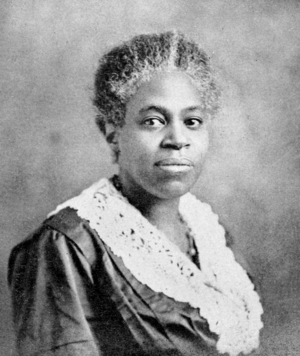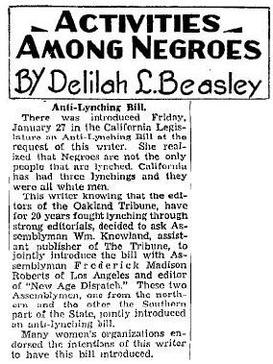Delilah Beasley facts for kids
Quick facts for kids
Delilah L. Beasley
|
|
|---|---|

Delilah L. Beasley, from a 1919 publication
|
|
| Born | September 9, 1867 Cincinnati, Ohio, U.S.
|
| Died | August 18, 1934 San Leandro, California, U.S.
|
| Occupation | Historian, columnist |
Delilah Leontium Beasley (born September 9, 1867 – died August 18, 1934) was an important historian and newspaper writer. She wrote for the Oakland Tribune newspaper in Oakland, California.
Delilah Beasley was the first African-American woman to have her writings published regularly in a major city newspaper. She also wrote a famous book called The Negro Trail-Blazers of California (1919). In this book, she proved that black pioneers lived in California a long time ago. Her writing career lasted more than 50 years. She wrote about the challenges faced by Black people in California. She also shared stories of their amazing achievements in the late 1800s and early 1900s.
Contents
About Delilah Beasley
Delilah Beasley was born in Cincinnati, Ohio. She was the oldest of five children. Her father, Daniel Beasley, was an engineer. Her mother, Margaret Harris, took care of their home. When Delilah was still a teenager, her parents passed away. She had to find a job to support herself. She became a trained masseuse, which is someone who gives massages.
She started writing for newspapers in 1883. Her first job was with a black newspaper called the Cleveland Gazette. She wrote short articles about church and social events. Three years later, she published her first column in the Sunday Cincinnati, Ohio Enquirer. It was titled "Mosaics." Delilah also studied journalism with Daniel Rudd. He was a well-known newspaper publisher in Cincinnati. Like Rudd, she was a very religious Catholic.
In 1910, when she was 39, Beasley moved to Oakland, California. She went to lectures and did research at the University of California, Berkeley. She also wrote essays to present at local churches. At that time, about 3,055 African Americans lived in Oakland. This small community had many of its own businesses, churches, and social groups. Several black newspapers were also published in Oakland. These included the Oakland Sunshine and the Western Outlook. In 1915, Delilah wrote for the Oakland Sunshine, reaching a black audience.
Her Book: The Negro Trail-Blazers
Delilah Beasley wrote about the "firsts" and great achievements of African Americans in early California. She put these stories in her book, The Negro Trail-Blazers of California (1919). This book was a collection of information from the California Archives. She also used old newspapers from 1848 to 1919. She especially looked at all the black newspapers published since 1855.
Beasley's book included diaries, life stories, poems, and photographs. It also had old papers and talks with early pioneers. It gave a full history of old laws and court cases. Her book is full of success stories. It lists hundreds of names of Black people in California from the pioneer days until the late 1800s.
Beasley wrote about the black gold miners from the late 1840s. She said: "A history of the Negro people of California would be incomplete without mention of the mining men who came in 1849. There were at one time several hundred Negro miners working claims... One such man was Moses Rodgers. He was a mining expert and one of the best mining engineers in the state. He also worked with metals and owned mines. The black miners rarely bought mining stock. They had more important things to do with their money. They used it to buy freedom for themselves, their families, or loved ones in the South. If not that, they gave a lot of their money to help the 'Executive Committee of the Colored Convention.' This group worked to get laws passed that helped the Negro race in California."
Beasley spent nine years writing her book. It is very important for people who study the history of California and the American West. It also helps us understand African American history in the West. She knew many people who had been in California since it became a state or even before. A lot of what we know about California's black pioneers comes from her book. One of her heroes in the book was Lt. Col. Allen Allensworth. In 1908, he founded an all-African American town in Allensworth, California. This town is now a state park called Colonel Allensworth State Historic Park. Beasley wrote that Colonel Allensworth was born a slave. Yet, she said few people had done more with their lives or helped others more than he did.
Delilah Beasley made sure to feature women prominently in her book. For the next 40 years, no other major books like Beasley's were published. This shows how special her work was.
Newspaper Columnist
Her hard work on The Negro Trail-Blazers helped Beasley become the first Black woman in California to write regularly for a major city newspaper. By 1925, Delilah was writing a Sunday column for the Oakland Tribune. Her column was called Activities Among Negroes. She often spent more than 40 hours a week gathering information for her column. She wrote about churches, social events, women's clubs, and local and national politics.
Beasley wanted to show the white readers of the Oakland Tribune a positive image of the black community. She did this by writing about the achievements of successful Black men and women. These were people from Oakland and other places. By highlighting these stories, she showed what African Americans were capable of. She also gained many readers for her column. She built a network of people who would give her information. Her work helped create better cooperation between different races in the 1930s. Richard Dillon, a writer, said that Beasley was "born 50 years before her time." Beasley wrote for the Oakland Tribune from 1925 to 1934.
Community Service and Activism
Delilah Beasley never married. She belonged to many community groups. These included The Delilah L. Beasley Literary and Improvement Club. She was also a member of the National Association for the Advancement of Colored People (NAACP). This group works for the rights of African Americans. She was part of the Alameda County League of Women Voters. She also joined the Public Welfare League of Alameda County.
In 1920, black women's clubs in Oakland, including Delilah Beasley, started the Linden Center Young Women's Christian Association (YWCA). They did this because the all-white YWCA branches were not welcoming to them. The Linden Center YWCA offered many services. These included religious and job training, adult education, and fun programs. In the mid-1920s, Beasley was a national historian for the National Association of Colored Women (NACW). She wrote about both groups in her column, Activities Among Negroes.
In 1929, Beasley used her skills to help create an International House at the University of California, Berkeley. Many landlords in Berkeley were against building it. They worried about many foreigners moving in. International House at UC Berkeley is a place where students from different cultures live and learn together. Its goal is to encourage respect and understanding between cultures. The university said that over 800 people protested the idea. At that meeting, Delilah Beasley, a black reporter, bravely spoke up. She defended the idea to a surprised audience. She stood up to property owners who feared the house would bring too many Black and Asian people to Berkeley.
Her weekly newspaper column helped her standing in the community. She could get good publicity for black political efforts. Her ability to influence the white community made her important to both white and black groups. As a journalist, she fought against using bad words about African Americans in the press. In 1932, Beasley helped arrange for a painting by a Black artist to be given to the Oakland Museum. She was president of the “Far Western Inter-Racial Committee.” A painting called "The Slave Mother" by Eugene Burk was given to the museum. Beasley hoped this would "open many doors to young aspiring Negroes." The museum director, William Clapp, was very thankful. He said it was the first artwork given to the gallery as a formal expression of racial culture.
In 1933, Beasley urged California State Assemblyman William F. Knowland to act. Knowland was also the assistant publisher of the Oakland Tribune. With Assemblyman Frederick M. Roberts, they introduced an anti-lynching bill. This bill passed easily in the California Legislature. It was the state's first law against mob violence.
Death
Delilah Leontium Beasley passed away on August 18, 1934. She died at Fairmont Hospital in San Leandro, California. She had heart disease and high blood pressure. At that time, she lived in Oakland, California. She was buried at Saint Mary Cemetery in Oakland. Twenty years later, a monument was put up for her. It says: "Author and columnist, a native of Ohio and for 25 years a resident of Oakland."
Legacy
The Cincinnati chapter of the National Association of Black Journalists honors journalists. They give out "Delilah Leontium Beasley Scholar" awards to students.
Works by Beasley
- Beasley, Delilah L. "Slavery in California", Journal of Negro History, vol. 3, (January 1919) (includes California Freedom Papers (1851–1856)
- ___________. The Negro Trail-Blazers of California (1919), reprinted 1969, 1997 & 2004
- ___________. Proceedings of the Fifteenth Biennial Convention, National Association of Colored Women: Held in Municipal Auditorium, Oakland, California, July 29 to August 6, 1926
Resources
- Brown, Hallie Q. Homespun Heroines and Other Women of Distinction (1925), Oxford University Press, reprinted (1988), Oxford University Press.
- Crouchett, Lorraine Jacobs. Delilah Leontium Beasley: Oakland's Crusading Journalist, El Cerrito, California, Downey Place Publishing House, (1990)
- Hine, Darlene, et al. Black Women in America: An Historical Encyclopedia, Carlson Publishing Inc., (1994)
- Roses, Lorraine E. Harlem's Glory: Black Women Writing, 1900–1950, Harvard University Press (1997)
- Streitmatter, Roger. Delilah, Beasley: A Black Woman Journalist Who Lifted As She Climbed, American Journalism Historians Association, October 1991, Philadelphia
- Wheeler, B. Gordon. Black California: The History of African-Americans in the Golden State, Hippocrene Books, New York, (1993)



